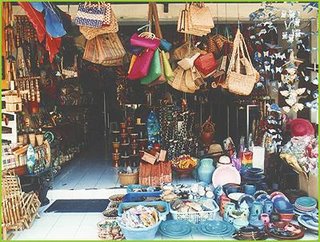
Arts In Ubud
Buying Art
If you like it, buy it. It's hard to know if you like it in an unfamiliar environment. Spend some time with a work, and see how it makes you feel. If it is a startlingly strong feeling, an excitement, then the chemistry is good. Buy it. Prices are generally not negotiable in the fine art galleries. For more "commercial" art, in the smaller, less formal galleries, however, you may ask if the price is open to discussion. Don't worry too much about price. Prices in Ubud, tend to be very, very reasonable. This holds for truly fine art, and also for the many attractive and decorative paintings that are produced and sold throughout the area. Don't turn up your nose a the latter category; much of the less expensive art available in Ubud clearly falls into the category of Folk Art or High Quality Craft. As such, most are works of lasting value, which will be greatly appreciated at home, and will perhaps appreciate in value as well.
Craft (As Opposed to Art)
Somewhere there is a dividing fine between "art' and "craft," and regardless of where you place the fine, the Ubud area has plenty of both. On the side of craft, there are scores of "art shops" lining the main roads which connect Ubud to surrounding towns. Notably, the road from Peliatan to Pujung, which is dotted with woodcarving galleries and other craft shops. In Tegallalang and surrounding villages you will find Bali's best Garuda and Singga carvers, among the cheesy pop-art wooden souvenirs. Small woodcarvings of every sort are widely available in Ubud, Tegallalang, Pujung, Nyuh Kuning, Mas, Teges, and in abundance at the Sukawati art market, about twenty minutes south of Ubud. You can get pieces in naturally-finished woods representing animals, religious figures, people and so forth. Some woodcarvings are art, and others are simply craft. We'll leave it to you to decide which is which.
Throughout the Ubud area, you can pick up inexpensive small paintings which make excellent decorative accents back home. Other crafts in the towns surrounding Ubud include weaving (Gianyar area), stone carving (Batubulan), basket making (Bona), bamboo and rattan work (Sakah and Bona), jewellery (Celuk), bone and coconut carving (Tampaksiring), batik, furniture making, bronze casting, and, decorative metalwork. Most guidebooks have a good map showing which towns are centres for which craft.
The entire Gianyar district is densely populated with craftspeople in every imaginable medium. The majority of them are delighted to create works to order, so let loose the latent designer in you. Simply bring along a sketch, sample, or magazine clipping. Alternatively, if you like what you see in a showroom, but have an idea how it could be improved, explain what variation you have in mind. Don't forget to agree on a price in advance.
One word of warning to craft-shoppers. Prices are usually very, very flexible. Be prepared to barter. But always be polite. Some merchants are firm about prices, and rightly so. A final word of warning. Tour companies, drivers and guides are given large commissions for bringing buyers to art shops, and the cost of the commission is tacked onto the price you pay. So if you want the best price, go on your own, or choose a driver or guide who agrees to take you shopping without chasing commissions.